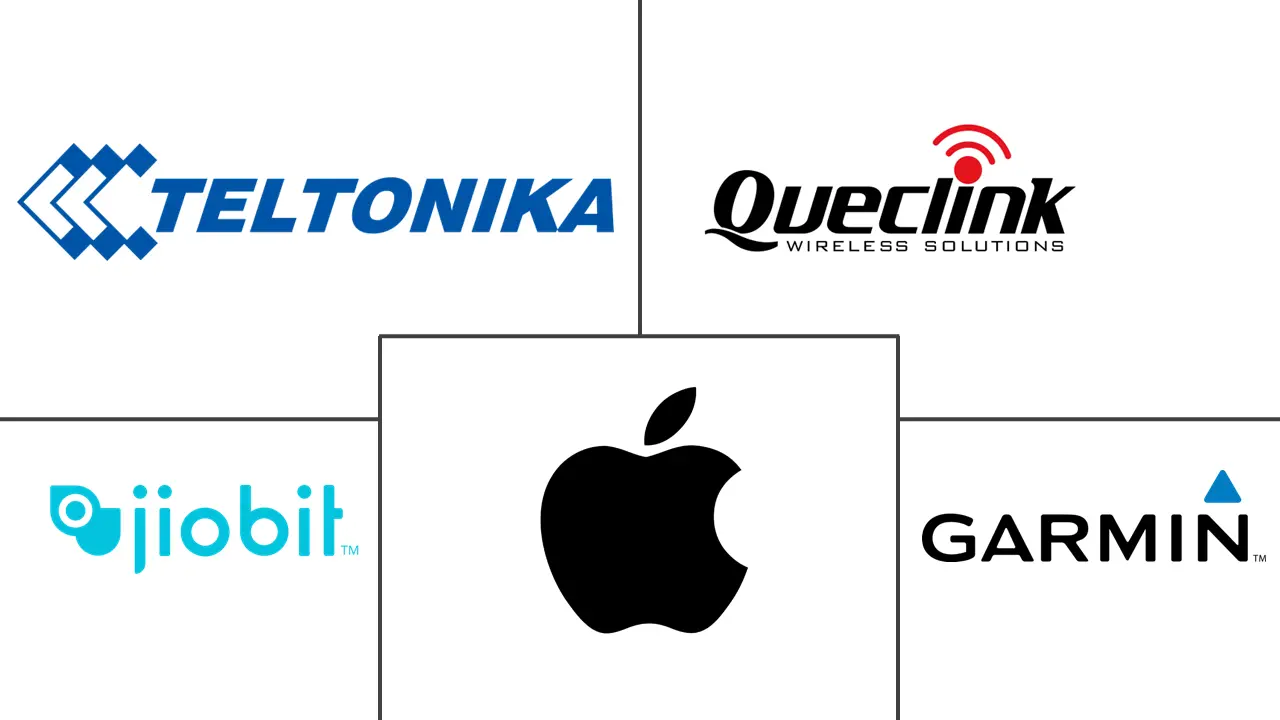Personal GPS Tracker Market Size and Share
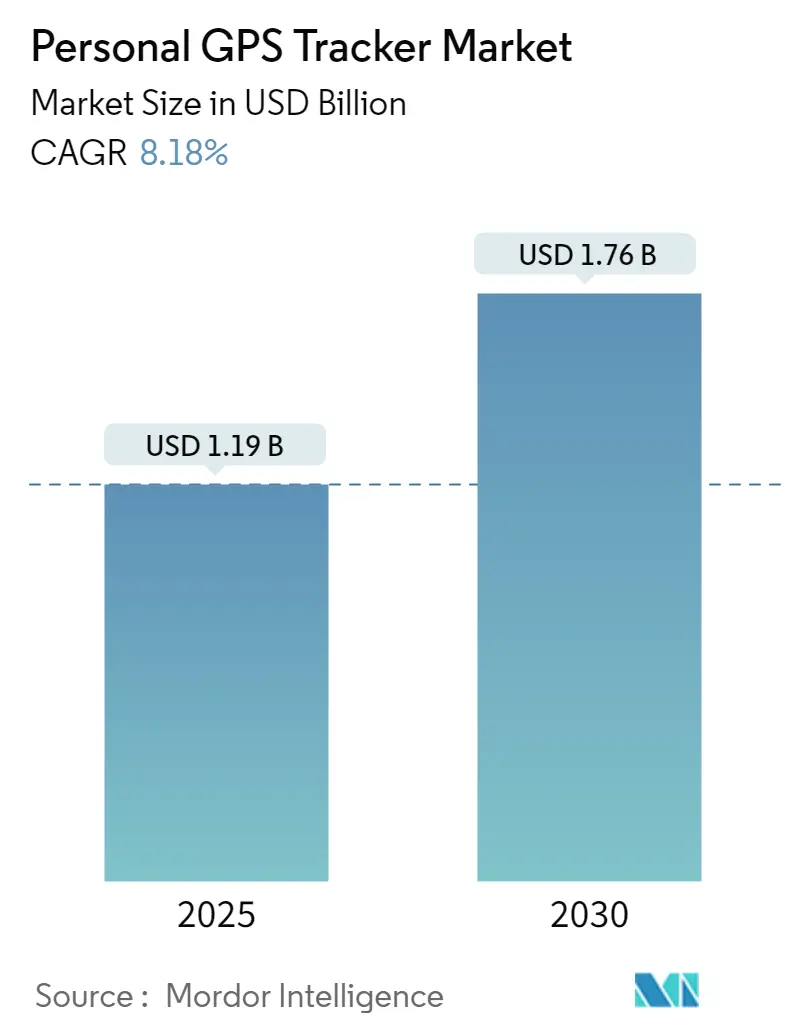
Personal GPS Tracker Market Analysis by Mordor Intelligence
The personal GPS tracker market size reached USD 1.19 billion in 2025 and is set to advance to USD 1.76 billion by 2030, reflecting an 8.18% CAGR. Growth aligns with rising security awareness, component miniaturization, and expanding use cases ranging from child safety to dementia care. Real-time location services now benefit from multi-constellation satellite coverage, while 4G LTE-M and NB-IoT networks improve indoor reception and battery life. Hardware cost erosion lowers entry prices, supporting adoption in emerging economies, and eSIM roll-outs simplify global roaming. At the same time, escalating data-privacy rules and GNSS spoofing episodes compel vendors to harden cybersecurity and diversify positioning technologies.
Key Report Takeaways
- By type, SIM GPS trackers led with 67.8% of personal GPS tracker market share in 2024; eSIM trackers are forecast to expand at 14.5% CAGR to 2030.
- By form factor, wearable watches held 55.2% of the personal GPS tracker market size in 2024, while smart footwear is growing at 17.9% CAGR through 2030.
- By application, children accounted for a 43.3% share of the personal GPS tracker market size in 2024 and pet tracking is advancing at a 15.3% CAGR through 2030.
- By sales channel, online direct-to-consumer captured 55.23% revenue share in 2024; subscription service providers post the highest projected CAGR at 15.8% to 2030.
- By geography, North America commanded 42.1% of personal GPS tracker market share in 2024, whereas Asia-Pacific is projected to rise at a 12.9% CAGR between 2025-2030.
Global Personal GPS Tracker Market Trends and Insights
Drivers Impact Analysis
| Driver | (~) % Impact on CAGR Forecast | Geographic Relevance | Impact Timeline |
|---|---|---|---|
| Heightened personal-security concerns | +2.1% | Global, with concentration in North America & Europe | Short term (≤ 2 years) |
| Hardware cost erosion and miniaturisation | +1.8% | Global, led by Asia-Pacific manufacturing hubs | Medium term (2-4 years) |
| Surge in pet-insurance platforms needing location data | +1.4% | North America & Europe, expanding to Asia-Pacific | Medium term (2-4 years) |
| Ageing population and dementia-care mandates | +1.2% | Global, particularly developed economies | Long term (≥ 4 years) |
| eSIM roll-outs simplifying global coverage | +0.9% | Global, faster adoption in developed markets | Medium term (2-4 years) |
| Adventure-tourism demand for SOS beacons | +0.7% | Global, concentrated in mountainous/remote regions | Short term (≤ 2 years) |
| Source: Mordor Intelligence | |||
Heightened Personal-Security Concerns
Public anxiety around kidnappings, elder wandering, and urban crime elevates location trackers from convenience devices to essential safety gear. Schools and care homes increasingly embed real-time monitoring in operational protocols, driving institutional volume orders. Families accept continuous tracking as a necessary trade-off for peace of mind, which raises attachment rates across child and senior segments. Vendors respond with tamper-alert straps and emergency two-way calling features. Government alerts on missing persons further integrate trackers into official response workflows.
Hardware Cost Erosion and Miniaturization
Shrinking GNSS chipsets and 16 nm IoT SoCs cut bill of materials costs while enabling slimmer designs. Sub-USD 25 entry devices now meet basic accuracy thresholds, widening appeal in price-sensitive regions. Smaller footprints allow integration into jewelry, footwear, and pet collars without altering user habits. However, reduced battery volume challenges designers to pair duty-cycle algorithms with energy-dense lithium-polymer cells. Suppliers that optimize power budgets secure design wins in high-growth smart-footwear and pet-tracking niches.
Surge in Pet-Insurance Platforms Needing Location Data
North American pet insurers bundle trackers to verify activity and reduce claim fraud, turning optional accessories into compliance devices. Tractive’s API lets underwriters pull daily movement logs to refine actuarial models and reward responsible owners[2]Tractive GmbH, “Tractive Partners With Pet Insurers,” tractive.com. As European carriers replicate the model, device OEMs add heart-rate sensing and caloric expenditure to support wellness-based premium discounts. Hybrid data-sharing agreements create new recurring revenue streams for platform operators.
Adventure-Tourism Demand for SOS Beacons
Global participation in trekking and overlanding lifts demand for satellite-enabled messengers that function beyond cellular coverage. Garmin processed 1,400 inReach SOS activations in 2024, demonstrating tangible life-saving outcomes. Dual-frequency GPS with Iridium short-burst data widens latitude for back-country adventurers, and ruggedized designs withstand extreme environments. National park authorities endorse certified devices, further validating the category.
Restraints Impact Analysis
| Restraint | (~)% Impact on CAGR Forecast | Geographic Relevance | Impact Timeline |
|---|---|---|---|
| Data-privacy and surveillance regulations | -1.6% | Global, stricter in Europe & California | Short term (≤ 2 years) |
| Battery-life limitations in ultra-small form factors | -1.2% | Global, affecting premium segments | Medium term (2-4 years) |
| Country-level GNSS jamming/spoofing incidents | -0.8% | Regional hotspots, expanding globally | Short term (≤ 2 years) |
| Import-chipset shortages for IoT radios | -0.6% | Global, concentrated in APAC supply chains | Medium term (2-4 years) |
| Source: Mordor Intelligence | |||
Data-Privacy and Surveillance Regulations
GDPR, CCPA, and the 2025 U.S. Executive Order 14117 impose explicit consent, data-localization, and disclosure duties on tracker vendors. Compliance lifts legal costs and slows feature releases that rely on cross-border analytics. Firms pivot to subscription models that monetize services rather than raw data, while privacy-by-design architecture becomes a purchasing criterion for institutions.
Battery-Life Limitations in Ultra-Small Form Factors
As casings shrink under 10 mm, battery energy density lags behind power requirements for real-time GNSS and 4G radios. Consumers demand week-long autonomy yet expect unobtrusive designs. Engineering trade-offs force compromises on update frequency or reliance on external charging accessories. In the premium segment, battery constraints cap adoption despite strong interest in jewelry-style trackers, keeping replacement cycles conservative.
Segment Analysis
By Type: eSIM Integration Disrupts Traditional SIM Dominance
SIM-based devices held 67.8% of personal GPS tracker market share in 2024 due to carrier subsidies and mature logistics. The segment produced reliable ARPU through bundled SMS plans and remains a baseline for budget devices. However, eSIM trackers are forecast to expand at 14.5% CAGR, reflecting friction-free onboarding and global roaming.
The personal GPS tracker market increasingly values remote subscription provisioning because it eliminates physical stock-keeping units per carrier and speeds large-scale enterprise rollouts. Thales expects installed eSIM and iSIM nodes to surpass 200 million by 2025[1]Thales Group, “The Rise of eSIM & iSIM,” thalesgroup.com. As export controls tighten, remote SIM management also simplifies compliance by letting OEMs localize profiles dynamically. SATELLAI’s satellite-only tracker further illustrates how embedded connectivity unlocks untethered coverage for niche adventure applications.
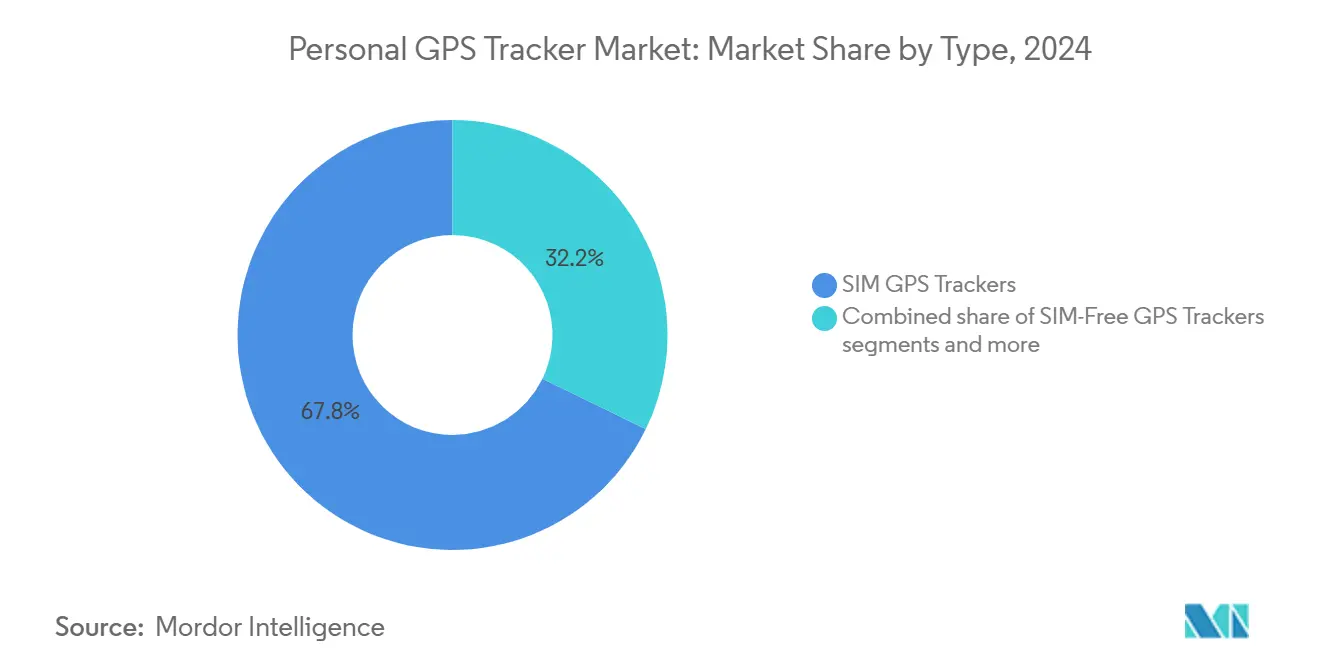
Note: Segment Share of all individual segments available upon report purchase
By Form Factor: Smart Footwear Emerges as Innovation Frontier
Wearable watches represented 55.2% of the personal GPS tracker market size in 2024 because consumers are accustomed to daily charging and screen interactions. High-resolution AMOLED displays enable fall detection and SOS messaging, cementing value in elder and adventure cohorts.
Smart footwear is projected to grow at 17.9% CAGR as passive tracking eliminates the need for user engagement. Midsole-embedded antennas and piezoelectric energy harvesters extend runtime beyond six months, a critical differentiator in dementia-care protocols. The personal GPS tracker industry also explores low-profile anklet tags for parole monitoring, underscoring broad form-factor experimentation.
By Application: Pet Tracking Accelerates Through Insurance Integration
Children held 43.3% of the personal GPS tracker market size in 2024 because schools and parents prioritized geo-fencing and attendance analytics. Device vendors pre-install SOS hotlines and content-filtering apps to boost perceived value.
Pet tracking is forecast to expand at 15.3% CAGR as insurers mandate activity logs. Bluetooth-assisted GPS reduces battery drain during indoor periods, while satellite uplinks guarantee coverage on hiking trails. The personal GPS tracker industry also taps AI-driven health scoring that flags deviations for early vet intervention.
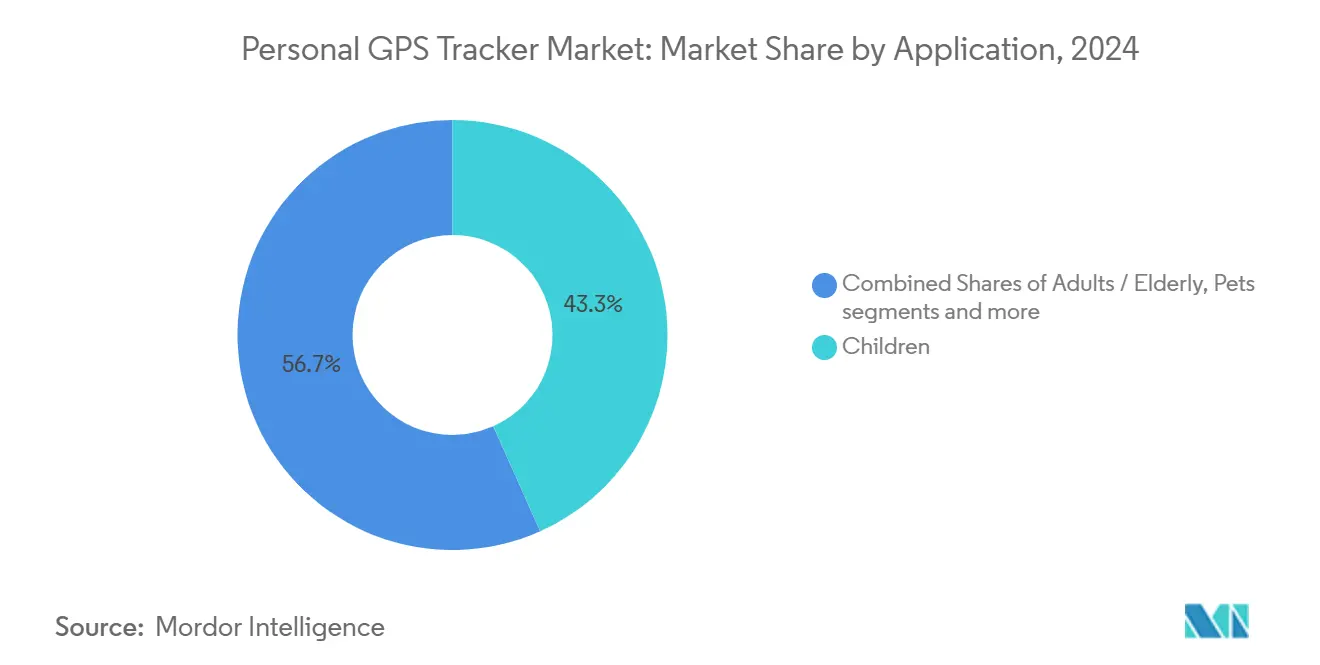
Note: Segment shares of all individual segments available upon report purchase
By Sales Channel: Subscription Services Challenge Direct Sales
Online direct-to-consumer captured 55.23% revenue in 2024, benefitting from SEO-optimized storefronts and influencer marketing. One-time hardware margins remain thin, prompting aggressive bundle pricing.
Subscription platforms are growing at 15.8% CAGR as they pair devices with continuous software upgrades, cloud storage, and data-loss guarantees. Life360 converted 9.2% of its 79.6 million monthly users into paid tiers in 2024, driving USD 371.5 million revenue[3].Life360 Inc., “FY 2024 Investor Presentation,” life360.com The personal GPS tracker market values predictable recurring cash flows that cushion hardware cycles and fund R&D.
Geography Analysis
North America led with 42.1% market share in 2024, reflecting mature consumer awareness and regulatory endorsement of location-based safety. U.S. demand skews toward premium LTE-M wearables that integrate two-way voice, while Canada showcases strong adoption of satellite SOS beacons for back-country recreation. Mexico emerges as a value-centric market where stripped-down 2G modules remain relevant for school programs. Data-sovereignty rules introduced in 2025 encourage domestic hosting, prompting cloud repatriation by U.S. vendors.
Asia-Pacific is the fastest-growing region at 12.9% CAGR from 2025-2030. China leverages scale manufacturing to flood domestic channels with sub-USD 15 trackers, stimulating mass adoption among delivery workers and students. India’s rising middle class pushes kid and pet tracker volumes through e-commerce flash sales. South Korea and Japan focus on aging-in-place solutions with LTE Cat-M1-enabled fall detection. Australia and New Zealand anchor adventure-tourism demand, integrating trackers into park permit requirements. Nordic Semiconductor captured 46% of new Bluetooth LE design wins across the region in 2024, highlighting the supply chain’s center of gravity.
Europe posts steady expansion under GDPR-driven privacy mandates. Germany subsidizes dementia-care wearables in statutory insurance, while the United Kingdom experiments with school-wide geo-fencing pilots. France promotes eSIM-only trackers to reduce e-waste, aligning with EU circular-economy goals. Eastern European markets seek affordable 2G and NB-IoT devices for personal safety amid urban crime concerns. Middle East & Africa witness rising adoption tied to expatriate child monitoring and workforce safety in oil fields, though price sensitivity remains high. South America, led by Brazil, adopts slowly but gains momentum from urban security initiatives that bundle trackers with smartphone contracts.
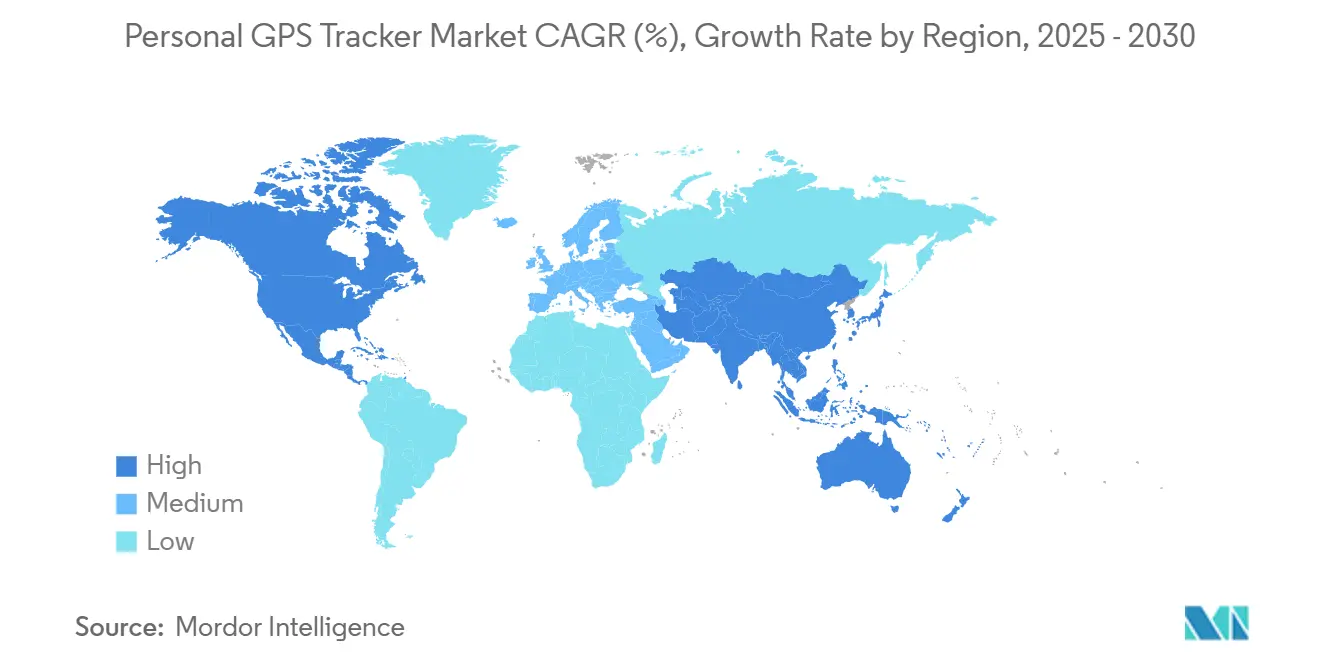
Competitive Landscape
The personal GPS tracker market supports a mixed ecosystem of consumer-electronics giants, specialist OEMs, and service-first platforms. Garmin strengthens its moat through multi-frequency GNSS and Iridium SOS integration, achieving 23% YoY revenue growth to USD 1.82 billion in Q4 2024. Apple and Samsung indirectly influence the space via smartwatch safety features, though their share is not counted in dedicated tracker shipments.
Life360 epitomizes the platform play, monetizing freemium location-sharing software and partnering with Bluetooth tag makers to expand hardware attach rates. Tractive and Fi focus on pets, using consumable subscription models tied to health analytics. BeWhere’s BeMini launch on Bell’s LTE-M network illustrates telco collaboration to widen coverage.
Component vendors such as Nordic Semiconductor and Qualcomm dictate reference designs, while MVNO enablers like emnify streamline eSIM provisioning across 180 countries. Competition pivots from raw GPS accuracy to holistic value propositions that bundle cloud dashboards, AI anomaly detection, and cross-border data compliance. M&A chatter centers on software platforms acquiring hardware specialists to own the full stack and lock in recurring revenue.
Personal GPS Tracker Industry Leaders
-
Garmin Ltd.
-
Apple Inc.
-
Teltonika Telematics
-
Queclink Wireless
-
Jiobit (Life360)
- *Disclaimer: Major Players sorted in no particular order
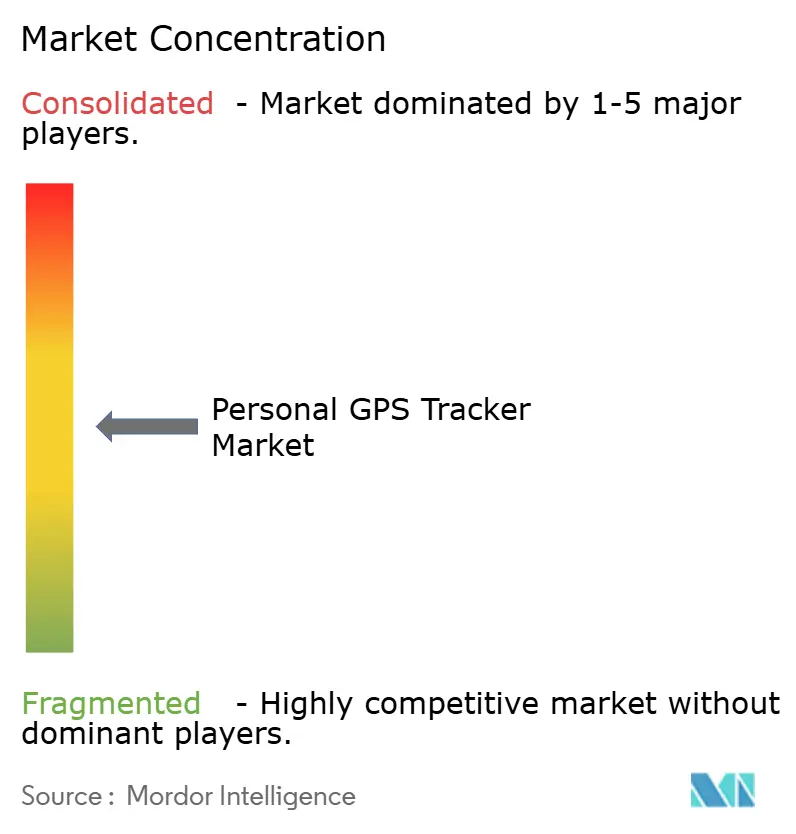
Recent Industry Developments
- March 2025: SATELLAI unveiled a satellite-powered pet tracker at MWC 2025 featuring solar charging and coverage across 680 networks in 180 countries.
- February 2025: Garmin reported record Q4 2024 results with USD 1.82 billion revenue and raised its dividend by 20%.
- January 2025: The U.S. Department of Justice implemented Executive Order 14117 restricting foreign access to precise geolocation data.
- March 2025: BeWhere launched the BeMini personal tracker on Bell’s LTE-M network in Canada.
Research Methodology Framework and Report Scope
Market Definitions and Key Coverage
Our study defines the personal GPS tracker market as revenue generated worldwide from dedicated, rechargeable devices that capture satellite signals and forward a wearer's or pet's position to a web or mobile dashboard through GSM, eSIM, or satellite links.
Scope exclusion: Smartphones, automobile telematics units, and Bluetooth-only tags fall outside this analysis.
Segmentation Overview
- By Type
- SIM GPS Trackers
- SIM-Free GPS Trackers
- eSIM-integrated Trackers
- Satellite Messenger Trackers
- By Form Factor
- Wearable Watch/Band
- Pendant / Tag
- Clip-on / Keyring
- Plug-in Vehicle OBD
- Smart Footwear
- By Application
- Children
- Adults / Elderly
- Pets
- Sports and Adventure
- Special-Needs Care
- Valuables / Assets
- By Sales Channel
- Online Direct-to-Consumer
- Subscription Service Providers
- Specialty Retailers
- Consumer-Electronics Stores
- Distribution Partners
- By Geography
- North America
- United States
- Canada
- Mexico
- South America
- Brazil
- Argentina
- Rest of South America
- Europe
- United Kingdom
- Germany
- France
- Italy
- Spain
- Nordics
- Rest of Europe
- Middle East and Africa
- GCC
- Israel
- South Africa
- Rest of Middle East and Africa
- Asia-Pacific
- China
- India
- Japan
- South Korea
- ASEAN
- Australia
- New Zealand
- Rest of Asia-Pacific
- North America
Detailed Research Methodology and Data Validation
Primary Research
We interviewed contract manufacturers in Shenzhen, subscription platform managers in Europe, and specialty retailers across North America. We ran short surveys with veterinarians and elder-care associations. These conversations validated shipment volumes, informed replacement cycles, and helped us reconcile desk estimates with real-world buying behavior.
Desk Research
We began with open data from regulators such as the US FCC equipment authorizations, Eurostat HS 852691 import codes, and Japan's Telec approvals. We then layered in pet-ownership statistics from APPA and child-population tables from UNICEF to size addressable demand. Company filings, investor decks, and patent families accessed through Questel hinted at average selling prices and feature roadmaps. News archives in Dow Jones Factiva and launch trackers like Bestsellingcarsblog highlighted regional product releases and promotional pricing. The sources cited are illustrative only; many additional publications guided data collection, cross-checks, and clarification of gray areas.
Market-Sizing & Forecasting
A top-down build starts with customs shipment volumes, which are then multiplied by region-specific retail price bands to derive 2024 revenue. Supplier roll-ups and sampled online channel checks serve as a bottom-up reasonableness test. Key model levers include child population aged 3-12, household pet penetration, wearable ASP trends, SIM module cost declines, e-commerce share in consumer electronics, and eSIM adoption rates. Multivariate regression on these drivers produces 2025-2030 projections, while scenario analysis adjusts for policy shifts such as Europe's upcoming battery directive. Gaps in channel data are bridged with moving averages, and assumptions are revisited after each round of expert calls.
Data Validation & Update Cycle
We run variance checks against import statistics and subscriber counts. Senior reviewers vet anomalies before sign-off. Reports refresh annually, and an analyst performs a fresh sweep whenever quarterly earnings or regulatory releases move baseline variables by five percent or more.
Why Our Personal GPS Tracker Baseline Commands Reliability
Published estimates often diverge because some studies mix asset trackers, add subscription revenue, or lock exchange rates months ahead, which creates inflated or conservative totals.
Key gap drivers: Certain publishers widen scope to include Bluetooth tags, others bundle cellular service fees, and several rely solely on wholesale units without retail price harmonization. Mordor's device-only scope, live currency updates, and yearly refresh temper extremes and give decision-makers a balanced figure.
Benchmark comparison
| Market Size | Anonymized source | Primary gap driver |
|---|---|---|
| USD 1.19 B (2025) | Mordor Intelligence | |
| USD 1.50 B (2024) | Regional Consultancy A | Includes subscription revenue and Bluetooth tags |
| USD 1.24 B (2024) | Trade Journal B | Relies on limited retailer sample; omits online mark-ups |
| USD 2.75 B (2024) | Global Consultancy C | Bundles vehicle OBD trackers; extrapolates wholesale units |
These comparisons show that Mordor's disciplined variable selection, dual-path validation, and timely refresh generate a dependable baseline that remains transparent and easy for stakeholders to retrace.
Key Questions Answered in the Report
What is the current size of the personal GPS tracker market?
The personal GPS tracker market size stood at USD 1.19 billion in 2025 and is projected to reach USD 1.76 billion by 2030.
Which region is growing fastest for personal GPS trackers?
Asia-Pacific is the fastest-growing region, posting a 12.9% CAGR between 2025 and 2030 on the back of urbanization and rising disposable incomes.
How are eSIM trackers changing the market?
ESIM trackers remove the need for physical SIM cards, simplify global roaming, and are forecast to grow at 14.5% CAGR to 2030, steadily displacing traditional SIM devices.
Why is pet tracking gaining momentum?
Pet insurers now require verified location and activity data, turning trackers into compliance tools and driving the segment’s 15.3% CAGR through 2030.
What are the main restraints facing the market?
Strict data-privacy regulations and battery-life challenges in ultra-small devices weigh on growth, reducing CAGR by an estimated 2.8 percentage points collectively.
Which sales channels are most lucrative?
Online direct-to-consumer currently delivers 55.23% of revenue, but subscription service platforms are growing faster at 15.8% CAGR as they lock in recurring income.
Page last updated on:
